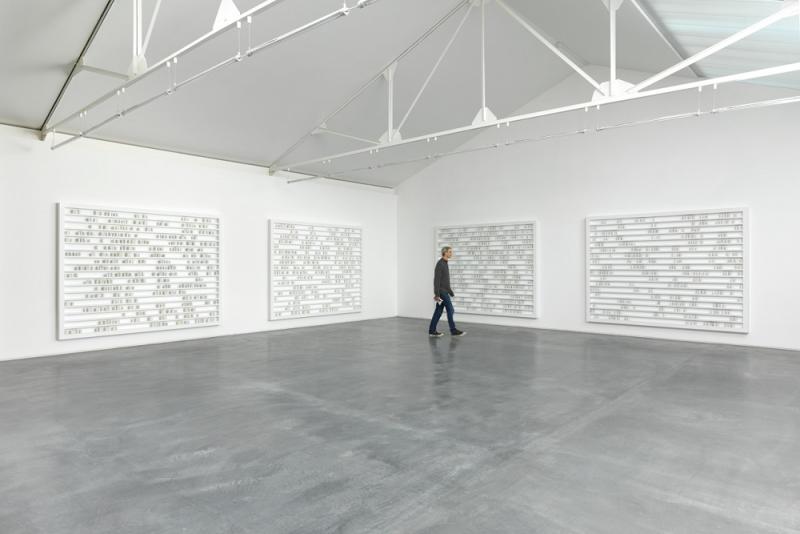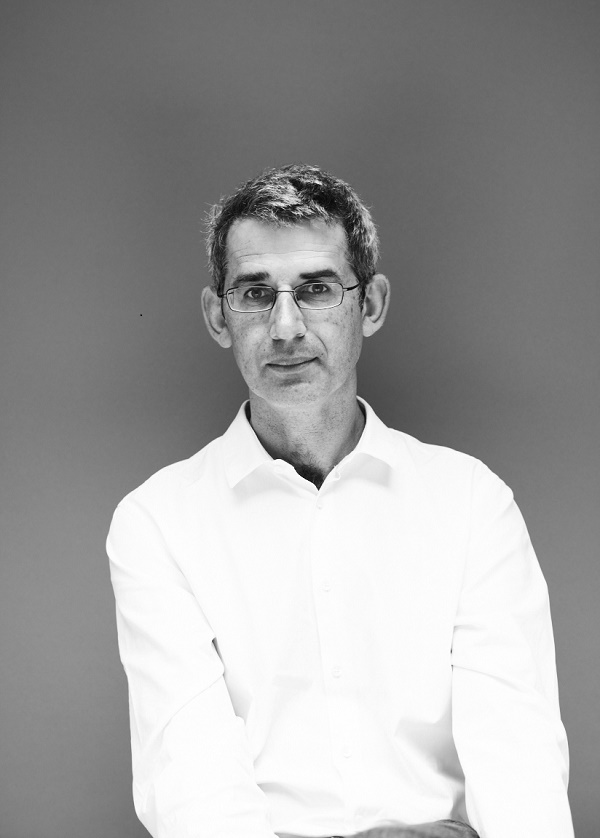Edmund de Waal: I Placed a Jar, Brighton Festival | reviews, news & interviews
Edmund de Waal: I Placed a Jar, Brighton Festival
Edmund de Waal: I Placed a Jar, Brighton Festival
The ceramic artist and author talks about pots, words and the burden of memory

What strange things netsuke are. Tiny sculptures, usually made from wood or ivory and depicting anything from figures, to fruit to animals, they were first made in the 17th century as toggles to attach pockets and bags to the robes worn by Japanese men. For as long as they have existed they have been considered highly collectible, and perhaps it is this, and the rapturous appreciation they inspire in their devotees, that to me at least makes them seem hopelessly, unspeakably kitsch.
Listening to the potter Edmund de Waal talking last night as part of the Brighton Festival, it struck me that perhaps my struggles with netsuke are the result of never having picked one up. In his acclaimed memoir The Hare with Amber Eyes, de Waal traces the history of the netsuke collection he inherited from his great uncle Iggy, uncovering in the process a remarkable family history that he relates with the skill of a consummate storyteller.
A pot is made to be touched as much as looked at, to figure in a daily routine
He spoke very movingly about the many hands that had held these little objects, the children in their nursery in Belle Epoque Vienna irrevocably connected to his own children through a shared experience separated by over a century. It is the tactile quality of the netsuke, the way they can nestle in the palm of a hand, or be carried in a pocket like a conker, that is key to their almost magical capacity as bearers of memory. To hold one in your hand, to look at it, is to begin to tell a story.
Above all else, de Waal is a storyteller, and when he tentatively asked whether anyone was familiar with his book, he appeared quite taken aback by the response. It looked as if the entire audience had read it, and it seems quite likely that many of the people there knew de Waal as an author first and a potter second.
Those who had read The Hare with Amber Eyes would have been familiar with his comparisons between making pots and telling stories, but the streak of self-deprecating humour was something new. “I have been making white pots for 45 years”, he said. “I find ways of framing them.” And of course by framing them, by placing them in a certain way, they have the space to speak, they can begin to tell a story. "I am a poet who uses pots," he explained.
 Helped along by de Waal’s lovely turn of phrase, it seemed possible to view pottery as roughly equivalent to netsuke. Formed on the wheel by its maker’s hands, a pot is made to be touched as much as looked at, to figure in a daily routine, acquiring accretions of meaning over time as it passes through countless different hands. And if there were any danger of lapsing into hyperbole, de Waal brought himself back to earth with a bump, relating the unceremonious depreciation that is the fate of all pots, as they make their way from pride of place, to draining rack, “to serving as the dog’s bowl, to the charity shop”. While other artists can aspire to longevity if not perpetuity, “all pots end up in the earth, broken”.
Helped along by de Waal’s lovely turn of phrase, it seemed possible to view pottery as roughly equivalent to netsuke. Formed on the wheel by its maker’s hands, a pot is made to be touched as much as looked at, to figure in a daily routine, acquiring accretions of meaning over time as it passes through countless different hands. And if there were any danger of lapsing into hyperbole, de Waal brought himself back to earth with a bump, relating the unceremonious depreciation that is the fate of all pots, as they make their way from pride of place, to draining rack, “to serving as the dog’s bowl, to the charity shop”. While other artists can aspire to longevity if not perpetuity, “all pots end up in the earth, broken”.
He wasn’t about to wax too lyrical about inheriting the netsuke, either. The glittering story of his staggeringly wealthy cousin Charles Ephrussi, who settled in Paris and spent his time and money on the great artists of the day, is just a chapter in the history of a family destroyed by the Nazis, the netsuke collection all that survives of their great empire.
He spoke amusingly - semi-seriously, it seemed - about the burden of inheritance, about how this collection of strange little objects had set him off on a wild goose chase that had taken years to bring to completion. I was not prepared for the wave of emotion that overtook him as he described the grim humiliation of his Jewish ancestors during the Anschluss. He gripped the lectern, his voice low, the words coming slowly and carefully as he told how his great grandfather Viktor had been forced to scrub the streets outside his Viennese palace until the brush broke.
In that moment, everything he had said about the power of objects as tangible “echoes of what people are thinking and feeling” seemed to crystallise. And so we came back to de Waal's pots, arranged in their vitrines like words on a page, words that we might not want or be able to articulate, but can only, somehow, feel.
Share this article
The future of Arts Journalism
You can stop theartsdesk.com closing!
We urgently need financing to survive. Our fundraising drive has thus far raised £49,000 but we need to reach £100,000 or we will be forced to close. Please contribute here: https://gofund.me/c3f6033d
And if you can forward this information to anyone who might assist, we’d be grateful.

Subscribe to theartsdesk.com
Thank you for continuing to read our work on theartsdesk.com. For unlimited access to every article in its entirety, including our archive of more than 15,000 pieces, we're asking for £5 per month or £40 per year. We feel it's a very good deal, and hope you do too.
To take a subscription now simply click here.
And if you're looking for that extra gift for a friend or family member, why not treat them to a theartsdesk.com gift subscription?
more Visual arts
 'We are bowled over!' Thank you for your messages of love and support
Much-appreciated words of commendation from readers and the cultural community
'We are bowled over!' Thank you for your messages of love and support
Much-appreciated words of commendation from readers and the cultural community
 Folkestone Triennial 2025 - landscape, seascape, art lovers' escape
Locally rooted festival brings home many but not all global concerns
Folkestone Triennial 2025 - landscape, seascape, art lovers' escape
Locally rooted festival brings home many but not all global concerns
 Sir Brian Clarke (1953-2025) - a personal tribute
Remembering an artist with a gift for the transcendent
Sir Brian Clarke (1953-2025) - a personal tribute
Remembering an artist with a gift for the transcendent
 Emily Kam Kngwarray, Tate Modern review - glimpses of another world
Pictures that are an affirmation of belonging
Emily Kam Kngwarray, Tate Modern review - glimpses of another world
Pictures that are an affirmation of belonging
 Kiefer / Van Gogh, Royal Academy review - a pairing of opposites
Small scale intensity meets large scale melodrama
Kiefer / Van Gogh, Royal Academy review - a pairing of opposites
Small scale intensity meets large scale melodrama
 Jenny Saville: The Anatomy of Painting, National Portrait Gallery review - a protégé losing her way
A brilliant painter in search of a worthwhile subject
Jenny Saville: The Anatomy of Painting, National Portrait Gallery review - a protégé losing her way
A brilliant painter in search of a worthwhile subject
 Abstract Erotic, Courtauld Gallery review - sculpture that is sensuous, funny and subversive
Testing the boundaries of good taste, and winning
Abstract Erotic, Courtauld Gallery review - sculpture that is sensuous, funny and subversive
Testing the boundaries of good taste, and winning
 Edward Burra, Tate Britain review - watercolour made mainstream
Social satire with a nasty bite
Edward Burra, Tate Britain review - watercolour made mainstream
Social satire with a nasty bite
 Ithell Colquhoun, Tate Britain review - revelations of a weird and wonderful world
Emanations from the unconscious
Ithell Colquhoun, Tate Britain review - revelations of a weird and wonderful world
Emanations from the unconscious
 Rachel Jones: Gated Canyons, Dulwich Picture Gallery review - teeth with a real bite
Mouths have never looked so good
Rachel Jones: Gated Canyons, Dulwich Picture Gallery review - teeth with a real bite
Mouths have never looked so good
 Yoshitomo Nara, Hayward Gallery review - sickeningly cute kids
How to make millions out of kitsch
Yoshitomo Nara, Hayward Gallery review - sickeningly cute kids
How to make millions out of kitsch
 Hamad Butt: Apprehensions, Whitechapel Gallery review - cool, calm and potentially lethal
The YBA who didn’t have time to become a household name
Hamad Butt: Apprehensions, Whitechapel Gallery review - cool, calm and potentially lethal
The YBA who didn’t have time to become a household name

Add comment